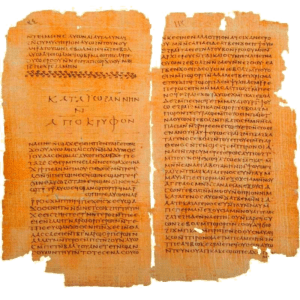The “Lost” Gospels

Looking for the “Lost Gospels” – Image by Free-Photos from Pixabay
Television documentaries about Bible history often are aired during the major Christian holidays, especially during Easter. These documentaries invariably include a spacial concerning the “lost” gospels. These books are also known as apocryphal gospels from the Greek meaning “hidden book.”
These “hidden” gospels purport to have been written by eyewitnesses to Christ’s ministry such as Peter, Judas, or Thomas – but they tell a story that is very different than the gospels included in Scripture. These differences are not minor, but so substantial that they are “shocking” making them a frequent topic of discussion on popular outlets such as the History Channel.
The new outlets will present these differences between the “lost” gospels and the Biblical gospels with such tropes as,
- Did the Church suppress the “real story” of the relationship between Jesus and Mary,
- Was Jesus really married, have children, and is buried at a “secret” location,
- Scholars unearth the ‘hidden’ truth about Judas and Jesus,
- Did Jesus “really” believe he was the Son of God?
These news and television outlets may stir some curiosity among viewers, so much so that Christians become confronted by these stories purporting to lend some doubt concerning the historicity of the orthodox account of Christ.
Christians need to have a response as to why these “lost” gospels are not real historical descriptions and deserve a place in the Christian Bible right next to the conventional gospels of Christ.
Four of the Apocryphal Gospels
Generally, there are four gospels that have attracted the most attention: the Gospel of Thomas, the Infancy Gospel of Thomas, the Gospel of Judas, and the Gospel of Peter.

Bringing Clay Birds to Life – By Unknown author – http://www.e-codices.unifr.ch/de/sbs/0008/28r, Public Domain, Link
Infancy Gospel of Thomas This gospel portends to account for the early years of Christ and was allegedly written by the Apostle Thomas. This is how this “gospel” begins,
The account of Thomas the Israelite philosopher concerning the childhood of the Lord:
I, Thomas the Israelite, tell and make known to you all, brethren from among the Gentiles, all the works of the childhood of our Lord Jesus Christ and his mighty deeds, which he did when he was born on our land.
The author then portrays several incidents from the early childhood of Christ. One of these incidences is as follows,
When this boy Jesus was five years old he was playing at the ford of a brook, and he gathered together into pools the water that flowed by and made it at once clean. … But the son of Annas the scribe was standing there with Joseph, and he took a branch of willow and dispersed the water which Jesus had gathered together. When Jesus was what he had done he was enraged and said to him, “You insolent, godless dunderhead, what harm did the pools and the water do to you? See, now you shall also wither like a tree and shall bear neither leaves nor root nor fruit.” And immediately the lad withered up completely. … After this, [Jesus] again went through the village and a lad ran and knocked against his shoulder. Jesus was exasperated and said to him: “You shall not go further on your way,” and the child immediately fell down and died. (Infancy Gospel of Thomas)
This gospel presents Christ as a petulant bully who would kill a child just for bumping into him. The story seems to be in dark contrast from the Christ presented in Scripture.

Gospel of Thomas – By Unknown author – Manuscritos en el tiempo, Public Domain, Link
The Gospel of Thomas is frequently presented on documentaries as being suppressed by the Church due to its unorthodox message. It is a collection of 114 sayings supposedly given by Christ to the Apostle Thomas. This is how the book begins and ends,
These are the hidden sayings that the living Jesus spoke and Thomas the Twin recorded.
The Gospel according to Thomas.
The book proclaims hidden messages and sayings which were given by Christ and recorded by Thomas. One of the most famous sayings is from the final ending of the gospel,
Simon Peter said to them, “Mary should leave us, for females are not worthy of life.” Jesus said, “Look, I shall guide her to make her male, so that she too may become a living spirit resembling you males. For every female who makes herself male will enter heaven’s kingdom.
Another famous “hidden” gospel is the Gospel of Judas. This gospel purports to give Judas a voice to counter the prejudice against him for his betrayal of Christ. It is the most recently discovered of the apocryphal gospels found in 1978 by peasants in a burial cave in Egypt. The book provided quite a commotion when it was presented close to Easter of 2006.
This gospel starts,
The Gospel of Judas,
The secret word of revelation that Jesus spoke with Judas Iscariot I the course of eight days, three days before he celebrated Passover.
In this story, Christ tells Judas he will give him teaching that was not presented to any of the other disciples.
And they ] the apostles] all said, “we are strong.” Yet the spirits could not dare to stand before him, except Judas Iscariot. He was able to stand before him, yet he could not look him in the eye, but rather turned his face away. Judas said to him, “I know who you are and where you have come from. You have come from the immortal eon of Barbelo, and from the one that has sent you, whose name I am not worthy to utter. But Jesus, knowing that he was thinking of something lofty, said to him, “Separate from them, and I will tell you the mysteries of the Kingdom.
What we have of this Gospel is very fragmentary, and it is difficult to determine whether Judas is the hero or the criminal who is ultimately condemned. There is much discussion between Judas and Christ considering esoteric knowledge “of the Kingdom” that is secret between them.

Gospel of Peter – By Henry Barcley Swete (1835 – 1917) – aus dem Buch Henry Barcley Swete: “The Akhmim Fragment of The Apocryphal Gospel of St. Peter.” Cambridge University Press. MacMillan & Co. London, 1893., Public Domain, Link
The fourth gospel to be considered is the Gospel of Peter. This book is written in Greek and is a fragmentary account of the death, burial, and resurrection of Christ. The book also discusses what the apostles did after the resurrection,
It was the first day of the Feast of Unleavened Bread. … But we, the twelve disciples of the Lord, wept and grieved; and each one returned to his home, grieving for what had happened. But I, Simon Peter, and my brother, Andrew, took our nets and went off to the sea. And with us was Levi, the son of Alphaeus.
This gospel also provides a different description of Christ’s last words,
Now it was midday and darkness had covered all Judea. … And many went about with lamps, since they supposed that it was night, and they stumbled. And the Lord called out and cried, “My power, O power, thou has forsaken me!” And having said this, he was taken up.
All these gospels purport to be written by one of the original apostles and present additional information or a different story than what is presented in Scripture. Of course, this is exactly what the media enjoy presenting – asking whether we have the “whole story” of Christ’s life and whether the “Church” is guilty of suppressing information – what “they” don’t want you to know!
What the media does not report is that “gospels” were immediately reported as forgeries and fakes by the Church Fathers. The “external evidence” strongly suggests that they are not authentic.
The opinion of the church fathers is thus remarkably different between what they said about the “lost gospels” and what they say about the four Biblical gospels. Each one of these four “hidden” gospels is described as fake and forgeries.

Irenaus – By Lucien Bégule – photo Gérald Gambier, Public Domain, Link
For example, Irenaeus noted about the Infancy Gospel,
[T]hey adduce an unspeakable number of apocryphal and spurious writings, which they themselves have forged, to bewilder Anoth the minds of foolish men, and of such as are ignorant of the Scriptures of truth. Among other things, they bring forward that false and wicked story which relates that our Lord, when He was a boy learning His letters, on the teacher saying to him, as is usual, “Pronounce Alpha,” replied Alpha.”
Irenaeus also noted,
Others again declare that Cain driver his being from the Power above, and acknowledge that Esau, Korah, the Sodomites, and all such persons, are related to themselves. … They produce a fictitious history of his kind, which they style the Gospel of Judas.
It was believed that the Gospel of Judas, which was discovered in 1979, was a “lost” gospel while in reality, it was well known to the early Church Fathers.
The second-century bishop of Serapion read the Gospel of Peter and noted,
But we, brethren, receive both Peter and the other apostles as Christ; but we reject intelligently the writings falsely attributed to them, knowing that such were not handed down to us.
The Gospel of Thomas is also noted by the early Church Fathers to be a forgery. Eusebius of Caesarea and Cyril bishop of the Church in Jerusalem in 350 AD agree,
]They are] writings which are our forward by heretics under the name of the apostles containing gospel such as those of Peter and Thomas. … To none of these has any who ever belonged to the ecclesiastical teachers ever thought it right to refer to his writings. Moreover, the type of phraseology differs from apostolic style, and the opinion and tendency of their contents is widely dissonant from true orthodoxy and clearly shows that they are forgeries of heretics.
Then of the New Testament there are the four Gospels only, for the rest have false titles and are mischievous. The Manicheans also wrote a Gospel according to Thomas, which being tinctured with the fragrance of the Gospel title corrupts the souls of the simple sort.
The church fathers were unanimous in believing that these ancient “lost” gospels deserved to be lost forever. They were forgeries, written to further the theology of Gnosticism which purported to have “secret” knowledge about God and Christ. We do not find a single ancient Christian authority to confirm the authenticity of these false gospels.
Summary of The “Lost” Gospels
Twice a year during Christmas and Easter, the History Channel or some other outlet will breathlessly portray the “lost” gospels to present a different picture of Christ and the Gospels. They hint that these “lost” gospels have been actively suppressed by the church (generally meaning the Catholic Church) because of the “secret” knowledge they contain.
History is unable to confirm the opinions of these news outlets. Instead, these false gospels were each known to the ancient Church Fathers who all label them as forgeries and fakes.
They were likely written by those with a different religious agenda trying to invoke secret knowledge held by only a few. This knowledge of the “secret” life of Christ or of the apostles would allegedly cause confusion for the common person and cast the Church in a poor light if it were publicized. Therefore, it would be kept secret for centuries until finally unearthed in the twentieth century.
It is hoped the public will become more enlightened to the false nature of these “lost gospels”, and that they were written as forgeries and fakes by those with other agendas.
References
Pitre, Brant: The Case for Jesus, 2016




